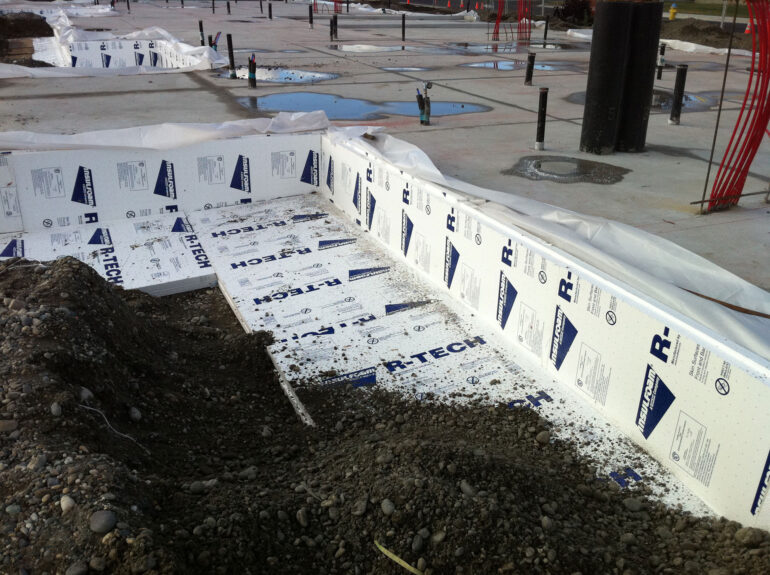
The Dirt on Below-Grade Insulation
Do buildings and homes really need insulation on their foundation walls and below their floor slabs? After all, weren’t partially buried buildings all the rage in the ‘70s, promising superior energy savings by insulating structures under several feet of dirt?
While it seems soil would be an effective insulator, it has an R-value of only 0.25 to 1.0 per inch at 20% moisture content, according to inspectapedia.com – which is much less than rigid foam insulations (EPS insulation, by comparison, has an R-value of about 4.4 per inch). As soil’s moisture content increases, its R-value drops even further.
The U.S. Department of Energy (DOE) notes that even though buried buildings are “less susceptible to the impact of extreme outdoor air temperatures,” they still require insulation. Quantifying this point, the EPS Industry Alliance says a lack of insulation on below-grade foundations, crawlspaces and under slabs accounts for up to 25% of a building’s total energy loss. And, the Green Building Advisor website explains, “If you live in Climate Zone 3 or anywhere colder, it’s cost-effective and wise to install basement wall insulation” – in other words, insulation below grade and under slab makes sense in most of the U.S.
Un-insulated concrete provides a thermal bridge between a building’s heated interior and the relatively cooler earth surrounding the building, or through exposed slab edges to the outside air. So, blocking that heat flow is critical for creating a comfortable, energy-efficient building. Additionally, below grade insulation helps manage moisture to reduce interior condensation on foundation walls. When installed on the exterior, rigid insulation helps prevent freeze-thaw cycling damage.
Once you’ve decided to insulate below grade, the next question is which insulation to use. For building teams that prefer the ease of working with rigid foam insulations, when choosing a product to install in below-grade applications, two crucial factors to consider are moisture resistance and thermal performance.
Moisture resistance
Just as a wet shirt is much less effective at keeping you warm than a dry shirt is, damp insulation is much less effective at blocking the flow of heat. Therefore, it is crucial to consider moisture performance when selecting insulation.
Rigid foam insulations commonly used below grade include expanded polystyrene (EPS) and extruded polystyrene. EPS performs significantly different from XPS in terms of moisture, and much confusion exists about which one is better. Ultimately, it depends on how you measure it.
EPS absorbs small amounts of moisture more quickly than XPS does, but also release moisture much faster than XPS does. This is crucial for understanding how these two insulation types perform in the field.
The soil surrounding the foundations of most buildings goes through periods of wetting and drying. XPS tends to hold onto moisture longer through this cycling, while EPS releases it and returns to high thermal resistance.
This was vividly demonstrated by the independent lab Stork Twin City Testing, which evaluated the moisture content of EPS and XPS buried side-by-side for 15 years on a laboratory’s foundation in St. Paul, Minnesota. At the time the insulations were removed, the EPS was four times drier than the XPS – the EPS had only 4.8% moisture by volume compared to 18.9% moisture content for the XPS. After 30 days of drying time, the EPS had dried to only 0.7% moisture by volume, while the XPS still contained 15.7% moisture.
Thermal performance
Moisture and thermal performance go hand-in-hand. The Stork Twin City Testing 15-year in-situ evaluation discussed above found that EPS retained 94% of its specified R-value, whereas the XPS only retained 52% of its R-value when wetted.
In addition to drying quickly and having minimal long-term moisture retention, EPS products do not experience thermal drift. This means that EPS insulations retain their published R-values during their time in service. This is because it is made with blowing agents that do not diffuse over time.
Conclusion
Soil is a much less effective insulator than you might think, so to avoid up to 25% of your home’s or building’s total energy loss, it is important to install insulation on buried foundation walls and beneath floor slabs. Given the frequent moisture exposure of insulation in these areas due to wetted soil, EPS insulations perform well and retain their R-value for long-term energy cost savings.
2 Comments
-
Interesting article. So, a question:
I have a cottage with a septic system. The municipality inspects every year which means I have to dig it up every summer and end up with a bald patch on my lawn.I’ve been thinking of framing the tank up to ground level, and filling the void inside the frame with insulation, and an easy to remove wooden cover.
I think the R value would be much higher than what I have now with just 24” of dirt, right?
-
Hi!
Yes, the R-Value of soil is 0.25 per inch where our products are 3.85 per inch for Type I.
-

